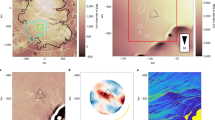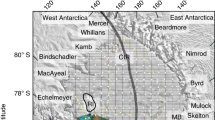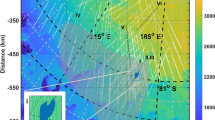Abstract
The Ronne Ice Shelf, floating between Berkner Island and the Antarctic peninsula, is the biggest ice shelf in Antarctica. It drains an estimated 1.2 × 106km2 of the Antarctic ice sheet, much of it resting on bedrock below sea level. Consequently, the balance and dynamics of this ice shelf is of importance to Antarctic glaciology, especially with regard to the integration of this part of the cryo-sphere into the global processes that control the climate of the Earth. Extensive radio-echo sounding (RES) by Robin and others revealed reflections in the central part of the Ronne Ice Shelf at the relatively shallow depth of 100–200 m below surface1. The interpretation of these echoes, which varied in strength, was ambiguous, and the possibility of internal reflecting horizons was thoroughly discussed. But after surface elevation measurements by radar altimeter from drifting balloons appeared to fit the presence of thin ice, it was decided to base a thickness map of the Ronne Ice Shelf on these RES echoes1–4. We now present direct observational evidence from boreholes that the total ice thickness is much greater than mapped, and that the shallow RES reflections therefore do come from internal horizons.
This is a preview of subscription content, access via your institution
Access options
Subscribe to this journal
Receive 51 print issues and online access
$199.00 per year
only $3.90 per issue
Buy this article
- Purchase on Springer Link
- Instant access to full article PDF
Prices may be subject to local taxes which are calculated during checkout
Similar content being viewed by others
References
1. Robin, G. de Q. et al. Nature 302, 582–586 (1983). 2. Crabtree, R. D. & Doake, C. S. M. Ann. Glaciol. 8, 37–41 (1986). 3. Drewry, D. J. (ed.), Glaciological and Geophysical Folio Sheet 4 (Scott Polar Research Institute, Cambridge, 1983). 4. Levanon, N., Julian, P. R. & Suomi, V. E. Nature 268, 514–516 (1977). 5. Taylor, P. L. Ice Drilling Technology, U.S. CRREL Special Report (U.S. Army Cold Region Research and Engineering Laboratory, Hanover, New Hampshire) 84–34; 105–117 (1984). 6. Kamb, B. et al. Science 227, 469–479 1985). 7. Gammelsrod, T. & Slotsvik, N. Polarforschung 51, 101–111 (1981). 8. Doake, C. S. M. Polar Rec. 18, 37–41 (1976). 9. Reinwarth, O. & Graf, W. Filchner–Ronne Ice Shelf Programme Report No. 2 (compiled by H. Kohnen) 7–17 (Alfred Wegener Institute for Polar Research, Bremerhaven 1985). 10. Robin, G. de Q. The Climatic Record in Polar Ice Sheets, 97; 121–122 (Cambridge University Press, 1983). 11. Morgan, V. I. Nature 238, 393–394 (1972).
Author information
Authors and Affiliations
Rights and permissions
About this article
Cite this article
Engelhardt, H., Determann, J. Borehole evidence for a thick layer of basal ice in the central Ronne Ice Shelf . Nature 327, 318–319 (1987). https://doi.org/10.1038/327318a0
Received:
Accepted:
Issue Date:
DOI: https://doi.org/10.1038/327318a0
This article is cited by
Comments
By submitting a comment you agree to abide by our Terms and Community Guidelines. If you find something abusive or that does not comply with our terms or guidelines please flag it as inappropriate.



